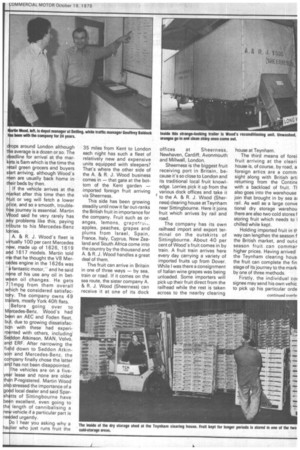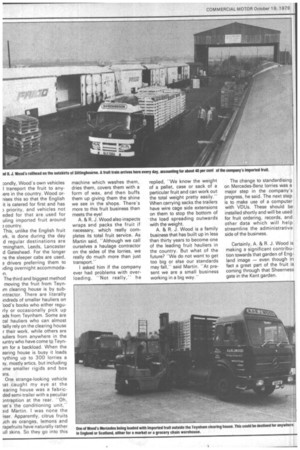Garden of Kent's expanding patch
Page 46

Page 47

Page 48

If you've noticed an error in this article please click here to report it so we can fix it.
David Wilcox travels to Kent to see how nat county most famous produce is handled and deliverec —and discovers that ere S more to the business -non home-grown fruit.
Brian Wea erley took e pictures,
JT — the Garden of Engf. Does that, I wonder, (e the M20 the garden path? took a trip down the M20 to t a specialised transport Ipany that helps Kent keep garden image. But I found this particular garden has a er large and important gate le bottom ...
& R. J. Wood is a haulage Ipany that carries almost exiively one type of product — t. It was started by two thers, Alf and Roy James od with a five-ton Austin in 51. They operated from a ner's yard in the village of )child near Sittingbourne ch is their home area and in heart of the prime fruitducing region. Their busis was naturally concentrated carrying this fruit to the Lon fruit markets, such as dent Garden and the laugh Market.
'Since then the company has landed so that it is now one of leading fruit hauliers, incorating a sister company, three s in the Sittingbourne area, dock offices at several ports Iandle imported fruit.
Wood's operating centre is ir the village of Detling oute Sittingbourne, ideally cod a stone's throw from the !O and incidentally, in some autiful countryside. The name Detling will be familiar to fly readers for its wartime .F station and the old airfield's iway is now the parking place the Mercedes-Benz tractive its operated by the company. e hangar is now a storeshed, nporarily housing English it before it is loaded for its trip the London markets. I say glish fruit as opposed to ported fruit, which is a quite )arate operation. Wood's depot manager at Detling is Martin Wood, Alf's son, and he explained to me 'how his special type of haulage works, beginning with the original basis of the firm, English fruit.
Local farmers (by local he means as far away as 20 miles) bring their fruit to Detling with instructions as to where it should go — mostly the big markets and wholesalers in London. If the farmer has more than a pallet or so of fruit or vegetables, then Wood's lorry will call on him en route to the markets. "We have to set a limit otherwise the driver would have so many pick-ups he would never ,reach the markets in time," said Martin Wood.
He went on to reel off a list of the English produce he regularly carries. Apples, pears, peas, greens, potatoes, strawberries, cherries, plums, and beans all make the journey to London.
Each afternoon around 4 pm six or seven of Wood's drivers report at Detling and meet their drivers' mates for the night. On this English fruit run Wood uses mates to help with the loading and unloading since many of the farms and markets do not have fork-lift trucks or loading banks and the sacks or cases have to be loaded and unloaded by hand.
The mates are mostly 19 or 20 years old and hoping to take their hgv class 1 licence eventually. Martin said he changes the combination of mates and drivers so that cliques do not, develop.
The drivers and mates pick up the vehicle (each driver has his own regular lorry) along with any fruit or vegetables that farmers have brought into Detling. They then set-off to pickup the fruit from the smaller farmers and can have anything up to a dozen pick-ups before heading northwards up the M20 for the 35-mile run into central London.
As well as delivering to the big markets, Wood's vehicles also make deliveries to the larger wholesale grocers and chain grocer warehouses. These can be scattered around the city, one being out near Heathrow airport for instance.
Martin said delays at the older. markets can be bad. "Places like the Borough were designed for horses and carts, not. artics, and they can get jammed-up inside." He thought the move from the famous Covent Garden, to Nine Elms near Vauxhall was a good thing as the new premises are more spacious and can off-load the vehicles more quickly.
Drivers can have up to 25 (tops around London although the average is a dozen or so. The deadline for arrival at the markets.is 5am which is the time the retail green grocers and buyers start arriving, although Wood's men are usually back home in their beds by then.
If the vehicle arrives at the market after this time then the fruit or veg will fetch a lower price, and so a smooth, troublefree journey is essential. Martin Wood said he very rarely has any problems like this, paying tribute to his Mercedes-Benz lorries.
A. & R. J. Wood's fleet is virtually 100 per cent Mercedes now, made up of 1626, 1619 arld 1617 models. Martin told rre that he thought the V8 Mercedes engine in the 1626s was -a fantastic motor,and he said none of his use any oil in betwen oil changes. He gets 711mpg from them overall which he considered satisfact y. The company owns 49 tr ilers, mostly York 40ft flats.
Before going over to M rcedes-Benz, Wood's had b n an AEC and Foden fleet, b , due to growing dissatisfacti n with these had experim nted with others, including S don Atkinson, MAN, Volvo, an ERF. After narrowing the fi Id down to Seddon Atkinso and Mercedes-Benz, the
pany finally chose the latter an has not been disappointed.
he vehicles are on a five
r lease and none are older Ith n P-registered. Martin Wood als stressed the importance of a go4d local dealer and said Sparsh tts of Sitting bourne have been excellent, even going to the length of cannibalising a ne vehicle if a particular part is ieçded urgently.
Do I hear you asking why a haL her who just runs fruit the 35 miles from Kent to London each night has such a fleet of relatively new and expensive units equipped with sleepers? That's where the other side of the A. & R. J. Wood business comes in — that gate at the bottom of the Kent garden — imported foreign fruit arriving via Sheerness.
This side has been growing steadily until now it far out-ranks the British fruit in importance for the company. Fruit such as oranges, lemons, grape*ru,, apples, peaches, grapes and plums from Israel, Spain, France, Italy, Cyprus, New Zealand and South Africa come into the country by the thousand and A. & R. J. Wood handles a great deal of them.
This fruit can arrive in Britain in one of three ways — by sea, train or road. If it comes on the sea route, the sister company A. & R. J. Wood (Sheerness) can receive it at one of its dock offices at Sheerness, Newhaven, Cardiff, Avonmouth and Millwall, London.
Sheerness is the biggest fruit receiving port in Britain, because it's so close to London and its traditional local fruit knowledge. Lorries pick it up from the various dock offices and take it to the A. & R. J. Wood (Sherness) clearing house at Teynham near Sittingbourne. Here it joins fruit which arrives by rail and road.
The company has its own railhead import and export terminal on the outskirts of Sitting bourne. About 40 per cent of Wood's fruit comes in by train. A fruit train arrives here every day carrying a variety of imported fruits up from Dover. While I was there a consignment of Italian wine grapes was being unloaded. Some importers will pick up their fruit direct from the railhead while the rest is taken across to the nearby clearing house at Teyn ham.
The third means of forei fruit arriving at the cleani house is, of course, by road, a foreign artics are a comm, sight along with British arti returning from the Contin€ with a backload of fruit. Tt also goes into the warehouse join that brought in by sea al rail. As well as a large conve tional dry storage warehou there are also two cold stores f storing fruit which needs to I chilled while kept.
Holding imported fruit in tlway can lengthen the season f the British market, and out-c season fruit can commar higher prices. Having arrived the Teynhann clearing hous the fruit can complete the fin stage of its journey to the mark, by one of three methods.
Firstly, the individual col signee may send his own vehic to pick up his particular orde 2.ondly, Wood's own vehicles I transport the fruit to any'ere in the country. Wood orlises this so that the English it is catered for first and has ) priority, and vehicles not eded for that are used for uling imported fruit around a country.
This, unlike the English fruit irk, is done during the day d regular destinations are -mingham, Leeds, Lancaster d Gateshead. For the longer 'as the sleeper cabs are used, a drivers preferring them to iding overnight accorn mode
The third and biggest method moving the fruit from Teynim clearing house is by subintractor. There are literally tndreds of smaller hauliers on 'ood's books who either regurly or occasionally pick up 3ds from Teynham. Some are cal hauliers who can almost tally rely on the clearing house r their work, while others are luliers from anywhere in the iuntry who have come to Teyn)rn for a backload. When the earing house is busy it loads wthing up to 300 lorries a )y, mostly antics, but including )me smaller rigids and box One strange-looking vehicle iat caught my eye at the earing house was a fabricded semi-trailer with a peculiar )ntraption at the rear. "Oh, iat's the conditioning unit," aid Martin, I was none the iser. Apparently, citrus fruits Jch as oranges, lemons and rapefruits have naturally rather ull skins. So they go into this machine which washes them, dries them, covers them with a form of wax, and then buffs them up giving them the shine we see in the shops. There's more to this fruit business than meets the eye!
A. & R. J. Wood also inspects wraps and packs the fruit if necessary, which really completes its total fruit service. As Martin said, "Although we call ourselves a haulage contractor on the sides of the lorries, we really do much more than just transport."
I asked him if the company ever had problems with overloading. "Not really,– he
replied, "We know the weight of a pallet, case or sack of a particular fruit and can work out the total weight pretty easily." When carrying sacks the trailers have wire cage side extensions on them to stop the bottom of the load spreading outwards with the weight.
A. & R. J. Wood is a family business that has built up in less than thirty years to become one of the leading fruit hauliers in the country. But what of the future? "We do not want to get too big or else our standards may fall." said Martin. "At present we are a small business working in a big way." The change to standardising on Mercedes-Benz lorries was a major step in the company's progress, he said. The next step is to make use of a computer with VDUs. These should be installed shortly and will be used for fruit ordering, records, and other data which will help streamline the administrative side of the business.
Certainly, A. & R. J. Wood is making a significant contribution towards that garden of England image — even though in fact a great part of the fruit is coming through that Sheerness gate in the Kent garden.












































































































































